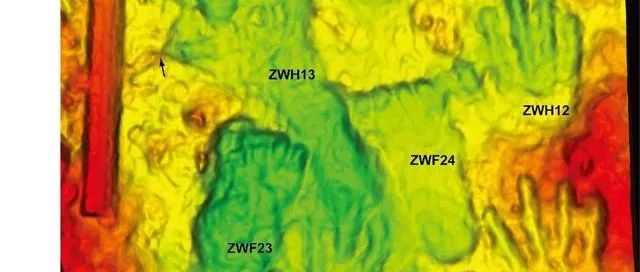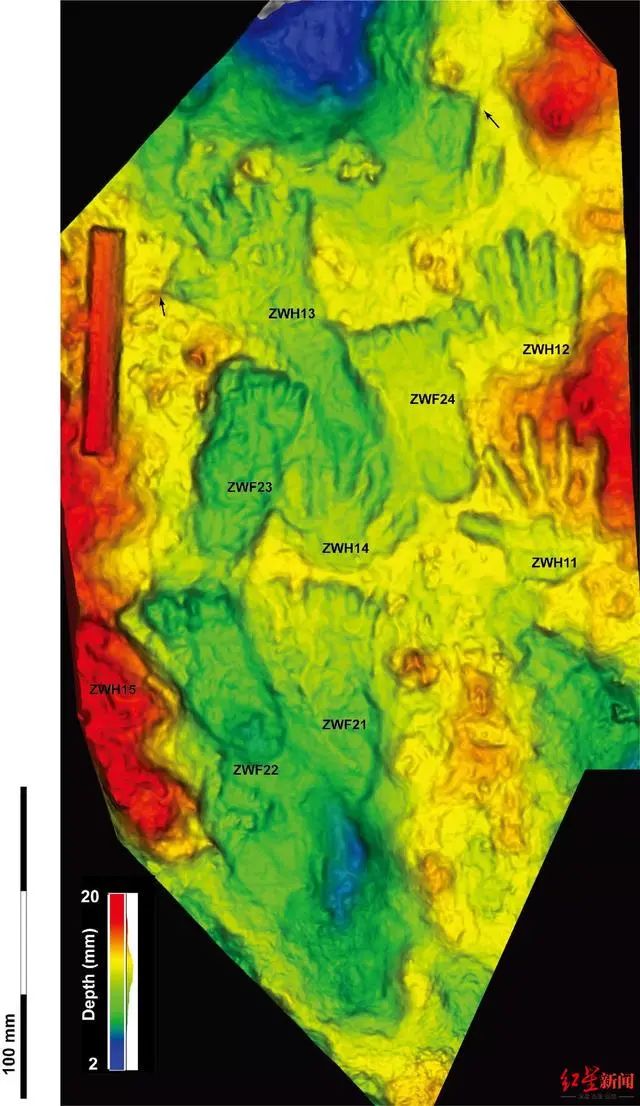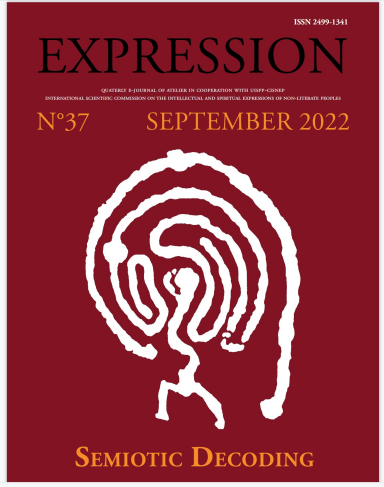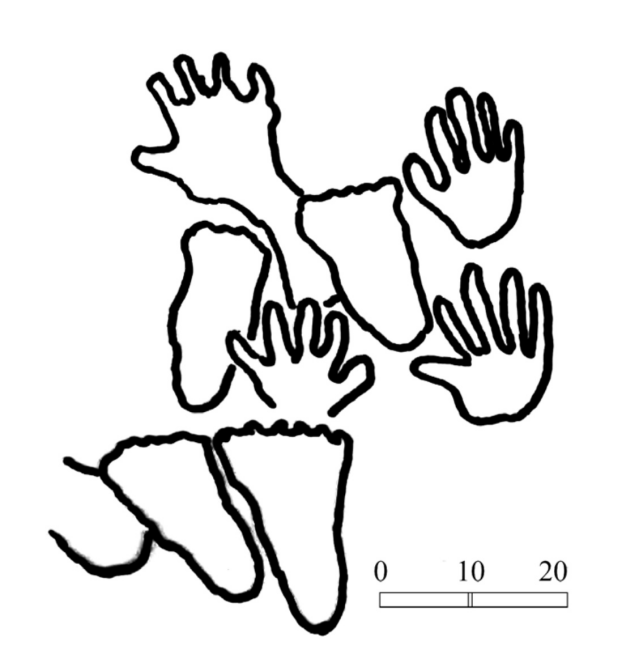深度阅读
两位岩画学者 谈邱桑手脚印遗迹


记事:《Expression》中的西藏邱桑手脚印遗迹

昨晚收到阿纳蒂教授主编的《表达》(Expression)2022年第37期。《表达》是意大利卡莫诺史前研究中心与美国国际科学委员会合作创办一份史前艺术研究的专业杂志,研究史前非文字部落人类智力和精神表达的电子期刊。本世纪初自阿纳蒂教授创办该杂志以后,几乎在每期寄送的同时,都要特别约稿。但因生性疏懒,加上痴笨愚钝,一直未能履约。但这一期上有两篇与中国岩画有关,也与自己有关,也算是交差了吧。其上有“论坛”(DISCUSSION FORUM)一栏,专门用于邀请世界各地相关的读者和学者积极参与跟人类学和岩画相关话题的讨论。

这期“论坛”栏目中刊登了河北师范大学汤惠生教授和卡莫诺史前研究中心阿纳蒂教授之间关于西藏邱桑人类手脚印遗迹的通信(Communications,between Tang Huisheng and Emmanuel Anati,on middle Pleistocene Tibetan handprints and footprints):
Dear Professor Anati,
The Qiu Sang handprint, not far from Lhasa, is an exciting rock art site found in Tibet, and there is also much debate about it. The same author in 2001 dated this site of handprints and footprints to 20,000 years BP and 20 years later to 200,000 years BP! Besides this author, other archeologists have proposed different dates, ranging from 8,000 to 200,000 years! Is the early dating credible? You are the leading world authority in rock art, your opinion would be most relevant and welcome.
尊敬的阿纳蒂教授:
邱桑手印是发现于西藏拉萨不远的一个令人兴奋的岩画艺术遗址,但它也有很多争议。2001年,同一作者在这个遗址确定另外的手印和脚印的日期是2万年BP,20年后又是20万年BP!除了这个作者之外,其他的考古学家还提出了不同的日期,从8000年到20万年不等!这些早期的断代可信吗?您是世界岩画艺术的权威,你的观点将是最切题和最受欢迎的。
Reply by E.Anati
阿纳蒂回复:
The Middle Pleistocene hand and foot prints at the Qiu Sang site on the Tibetan Plateau, c. 4000 m asl was presented in the article of David Zhang and 18 other researchers, and in other papers, awakening worldwide excitement.
在岩画研究者的论文中,中更新世的手印和脚印发现于青藏高原约4000米海拔的邱桑遗址,这引起了全世界的兴奋。
Such prints of limbs, produced by stepping and touching mud before it became solidified, were attributed to a date between 169 and 226 ka BP. The authors interpret the occurrence as a deliberate act that produced a work of art, an intentional composition of hand and foot prints. The
first question coming to one’s mind is what may have been the purpose and function of this association of hand and foot prints. Besides this central question, two other queries arise, First, are the proposed dates reliable? Second, was it an intentional artistic act intended to immortalize this assemblage of imprinted limbs?
这种四肢的痕迹是在石灰华凝固前踩踏和触摸产生的,被认为是在169到226 ka之间。作者将这一事件解释为一种有意的行为,产生了一件艺术作品,一种有意识的手脚印的组合。这使人们想到的第一个问题是,手和脚印的联系的目的和功能可能是什么。除了这个核心问题之外,还出现了另外两个问题,首先,断代的日期可靠吗?第二,这是一种旨在记录自己四肢印记的有意识的艺术行为吗?
Regarding the first query, the imprint on mud, now solidified travertine, implies a time previous to the fossilization of travertine. It could hardly be much later than what is proposed. The attribution to the Middle Pleistocene is reliable. The second query concerns the conceptual meaning. The sizes of both hand and foot prints are smaller than those of an adult Tibetan of today. The maker may either be an adolescent or a pygmy, an individual having small limbs. According to the article mentioned, the imprints belong to two people.
关于第一个问题,石灰华上的印记,现在已经凝固,意味着石灰华石化之前的一段时间产生的,不可能比确认的时间晚多少。换句话说,认为是中更新世的测年是可靠的。第二个问题涉及到概念上的意义。手印和脚印的尺寸都比今天的成年藏族人要小。制造者可能是一个青少年,也可能是一个侏儒,一个四肢很小的人。根据文章中提到的内容,这些印记属于两个人。
The photo displays the prints of five legs and four hands. All of the leg prints seem to relate to a right leg, while three of the hand prints belong to the right hand and one to the left hand. The three right hands show the same peculiar position of the thumb. Also, the foot prints are likely all to belong to the same individual. The question is do they indeed belong to two different people, or just to one and the same person?
这张照片显示了五只脚和四只手的印记(图一)。所有的脚印似乎都与右脚腿有关,而其中三个手印属于右手,另一个属于左手。这三个右手显示出与拇指相同的特殊位置。此外,这些脚印很可能都属于同一个人。问题是,它们确实属于两个不同的人,还是仅仅属于同一个人?

图一 西藏桑邱手脚印的轮廓描摹
Whatever the case, they do not represent a recurring cultural pattern. Deliberately made Paleolithic hand prints are retained to be signatures or acts of presence, related to initiation rites or intertribal agreements. Their presence is documented in the last 70,000 years, at least 100,000 years later than this case. The presence of both hands and feet assembled together in deliberate visual compositions is unusual in Paleolithic graphic representations.
无论如何,它们并不代表一种反复出现的文化模式。精心制作的被保留下来的旧石器时代手印作为签名或证明存在的行为,与入会仪式或部落间协议等仪式有关。这些手印被记录在过去的7万年里,至少比邱桑这个案例晚了10多万年。在旧石器时代的图形表现形式中,双手和脚组合在一起的遗迹是不同寻常的。
According to the photo, both handprints and footprints reveal the deep imprint indicating an effort. At least two of the four hand prints show the position of pushing. The evident signs of pressure of the foot prints seem to testify the action of pushing aside the block. The superposition of feet and hands indicates successive actions at pushing the block. They appear to be the result of a physical action to move the mud block. The presumed intent of producing a piece of visual art does not seem likely. The term rock art seems to be out of place. To our minds, it may just be the result of the effort of a single individual to move a block of mud. The finding is relevant as a testimony of homo’s presence in that area, at that time, but does not seem to illustrate the existence of art in Tibet over 100,000 years before any other place in the world.
根据照片,手印和脚印都显示了深深的印记,表明了有意识的用力行为。四个手印中至少有两个显示出推搡的位置。脚印上明显的压力迹象似乎证明了拟将石灰华泥块推开的行为,而脚和手的叠加表明了推动泥块的连续动作。它们似乎是为了移动泥块这一物理行为的结果,而制作一件视觉艺术的假设意图似乎不太可能。岩画艺术一词在这里似乎不合时宜。在我们看来,这可能只是一个人努力移动一块泥块的结果。这一发现只是证明了人类在该地区的存在,但似乎并不能说明西藏的岩画艺术比世界上任何其他地方早10万多年。
这一期《Expression》的主打文章有四篇:
意大利阿纳蒂(Emmanuel Anati) 的《岩画类型学》(The Typology of Rock Art)。
美国卡罗尔·帕特森(Carol Patterson) 的《阿帕奇岩画艺术中的阿帕奇战士与农民》 (Apache Warriors and Farmers in Apache Rock Art)。
印度罗摩·克里希纳·皮西帕蒂的《印度南部泰米尔纳德邦西北部地区的岩画艺术》(Rock Art of the North-Western Region of Tamil Nadu in South India)。
中国李曼、施兰英、汤惠生的《中国四川珙县坟颈子明代祈雨岩画的考释》(Interpretation of Rock Paintings: Praying for Rain in the Ming , from the Fen Jingzi Rock Art Site, Gong County, Sichuan Province, China)。

本文转载自“惠生盘古”公众号,转载时未获授权,特此说明
